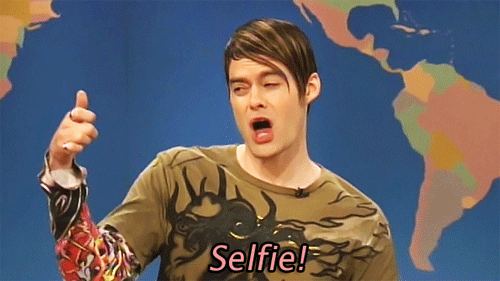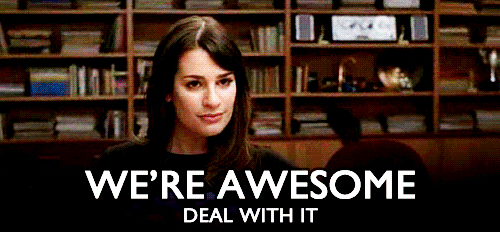I have a confession to make: I’m a pearl clutcher.
Okay, so maybe not exactly, but I have caught myself in the title of this post a few times.
While this fact isn’t the most inspiring thing in the world, it’s true. I’ve done some debatably-innovative-depending-on-who-you-ask-but-whatever-I’m-proud things. AND, I’ve uttered the phrase “It’s always been done this way.” Sometimes with a judgy air for the practice; sometimes in earnest and with a tinge of defensiveness.
 |
| Black and white picture of a woman clutching her pearl necklace. |
Let me start with a disclaimer that while this may be read or interpreted through a few different lenses, I am writing this out of intense care for the people who make up the Profession, not the Profession itself; and it hurts my heart when librarians of all types retreat into self-preservation mode even though they very much want to do good work in their communities. Those that feel stuck in unworkable situations and are wondering how they got there. It happens a lot, and the constant fear of budget cuts is only part of the problem. This is not an advice post, but a reflection on things that have worked for me. And if you read this with from a place of meanness or self-protection, please revisit it later.
Us vs Them
As I’ve alluded to above, I have found myself acting as a “pearl clutcher” and a “change agent”. The “pearl clutchers”, as the connotation goes, have much historical insight but who appear stuck in their ways, known for saying “”It’s always been done this way!”. They also wear sensible shoes. Conversely, as the connotation goes, change agents are go-getters but they may change things for the sake of changing it up rather than through careful reflection, or barrel through to make changes fast. The also have wild hair of some sort and probably Snapchat or Kik or whatever.
 |
| Person miming a cell phone taking a selfie |
The things that makes this so appealing is the human tendency to think in an “us versus them” way. And in order to make people fit in these packages, to figure out who to align to, we come from a shame-based place. A lot has been said about shaming-- slut-shaming, fat shaming-- and shame-based systems are real (I know that link is about families, but how many work teams say they’re “like a family”? That’s the thing about families-- they can be dysfunctional). One aspect of shaming is any time you see a quality in someone or they happen to do something and your reaction is “They are this type of person.” A co-worker is unproductive for any number of reasons? They are a lazy worker. A coworker is terse when talking about a deadline? They’re an impatient person. And by labeling them as such, we can guess what their actions would be in any other scenario. We can post to social media and say “look at this impatient person” and your fellow patient (read: decent and acceptable and worthy of your time) people can join in your judgment.
 |
| Three people looking sternly. Text says "judgy face." |
When you label someone as a pearl clutcher or a change agent, or whatever words you have for those tropes, you are putting yourself in a space where you don’t have to listen to concerns that may be actually legitimate, even if they’re legitimate only because your co-worker/director/employee has them. Which is the easiest way to deal with things, if we’re being honest. And they may only be able to articulate their concern by saying “We’ve always done it that way,” not being used to their further opinion mattering (or feeling that there is an openness to share).
What can we do?
As I assured you of earlier, this is not an advice post, but I hope to have a frank (though kind) discussion about how we can work together. When pearl clutchers and change agents are so frustrated to rely on self-preservation to survive, the creative parts of their brain shut down, and it’s difficult to process new events. They may retreat into unhealthy defense mechanisms. This absolutely sucks and is difficult to rebound from let alone work through. I’d love for all libraries to be cultures where everyone feels like “I’m the best compared to nobody” (that link is broken and I'm so sad. I didn't make up that phrase and the person at Brave New Kitty did not use their name, so I can't correctly credit them) and each team member feels equally valid and valued.
 |
| Two people finding each other across a room. Text says, "we're awesome; deal with it" |
I’m reflecting on situations as both a “pearl clutcher” and a “change agent.” In my 11 years of professional employment, here are a few questions that I’ve found helpful when approaching change to ask both myself and others:
“Can you tell me a little bit about the history of this program?”
This empowers those with historical insight as well as allows for people without this insight to become enlightened. Many times “we’ve always done it this way” is code for “There was a lot of thought/time/effort/money put into this, and I don’t see a change as honoring that fact.” This question is the first step in reflecting on current practice, which should be the foundation of any change (even though, “well, this looks silly. Doesn’t this look silly, person whose views are pre-aligned with mine?” can feel like fun. I cringe at the way I’ve approached change in previous positions, even if the outcomes were positive). A first answer might be “Well, I don’t recall how it started.” A follow-up can then be, “can you tell me what you do know?”
“What is the goal of the existing procedure?”
This allows us to reflect on the needs of the community and the outcomes of the procedure/program/whatever. Any changes made should focus on meeting this goal better, or re-evaluating the goal. Sometimes this takes a little digging and personal assessment. It may not be something anyone can immediately answer for you.
“How would this change affect our workflow?”
While I’ve seen this question scoffed at-- though it’s sometimes phrased as a declarative: “that sounds hard/inconvenient”--it’s a valid question that is necessary to answer. What butterfly effect would a new program or procedure have on workflow? Addressing this when discussing change can help dispel misconceptions. If the proposed change ends up seeming difficult, ask yourself about the goal of the change and see if you can approach it in an easier or more convenient way. If that’s not possible, a promise to re-evaluate the new program after a pilot period can do wonders to get others on board.
“What need does this change meet?”
One of my favorite library futurists-- I’m too jaded to even enjoy anyone else with that title AND I UNDERSTAND THAT’S A PEARL-CLUTCHY THING TO SAY THANKS-- is Joan Frye Williams. One thing that resonates me from watching her webinars is an idea that I mentioned above: Change for the sake of changing things is a road to ruin. Or, at the very least, an empty bandwagon. Any change you want to make--yes, even introducing new technology/STEM programming/Whatever is Being Tweeted Right Now!-- should be in response to a need you see in your community. If you want to introduce coding in your library, however, consider this shameless plug for the resources at Wiscode Literati your present for today.
“What does success of this program look like?”
Whether we’re talking about a new program or an existing one, it’s good to know what success looks like so everyone knows what to look for. Is it measurable by numbers? By anecdotes? Is there a system for assessment, or can we put one in place? Hint: “children enjoy using the library” is a totally fine measure of success. Maybe not for competitive grants.
“What are you afraid of happening if this change is/is not made?”
This question comes from the education world and I think it’s great to use, especially if a person seems confrontational or defensive. It has to come from a place of trust and vulnerability, however, and not condescension or accusation. This takes the problem and places it in worst-case-scenario land, and places you and your team on the same side, analyzing it. Maybe someone is against an idea because they’re afraid of becoming irrelevant. This may be common in the changing world of libraries, but this fear is a great opportunity to find a place for this person in the change and involve them more closely! They might be afraid that a certain community will be marginalized or remained underserved. The case may be that if this new program cannot happen, this community can be better served by folding in a special focus on that community to an existing service. Maybe they would not be particularly afraid of anything, they just know that it has been tried before and it did not work. This would be an opportunity to ask specific questions about what parts did not work and go back to the drawing board with the idea.
What Works for this Reformed Pearl Clutcher/Change Agent
If you find yourself mentally shooting down an idea: your input is valid. Take a deep breath; you will do your best work here to come from a place of openness. I remember an awesome presentation by Stef Morrill, director at WILS, where she suggested to repeat the phrase “open open open” to yourself (yeah, like the Mervyn’s commercial. But it sometimes helps!). Then? Ask questions. It’s difficult, but understand that the alternative will be remaining unheard and possibly feelings of resentment, which is a terrible feeling you do not deserve to feel. Ask yourself why this particular idea strikes a chord. Ask the person with the idea some of the questions above. Ask for clarification if you’re unclear. Offer your historical insight and a hand.
When you’re thinking about bringing a new idea to the table, consider that each one doesn’t need to be fully formed to work! My second day of work here I actually started a document called “Half Baked Ideas.” This is a list of ideas that I think of at random times that I either can’t dedicate time to at the moment or I otherwise don’t want to forget. Sometimes they sit, getting more fleshed out; sometimes I discuss them with team members for input. Some are those things I would like to do but should be paired with a need I haven’t found yet. I’ve also learned that it’s completely okay to say, “I’ve noticed [insert need here]. What do you think?”
So that’s my question I pose today: what do YOU think?

No comments:
Post a Comment